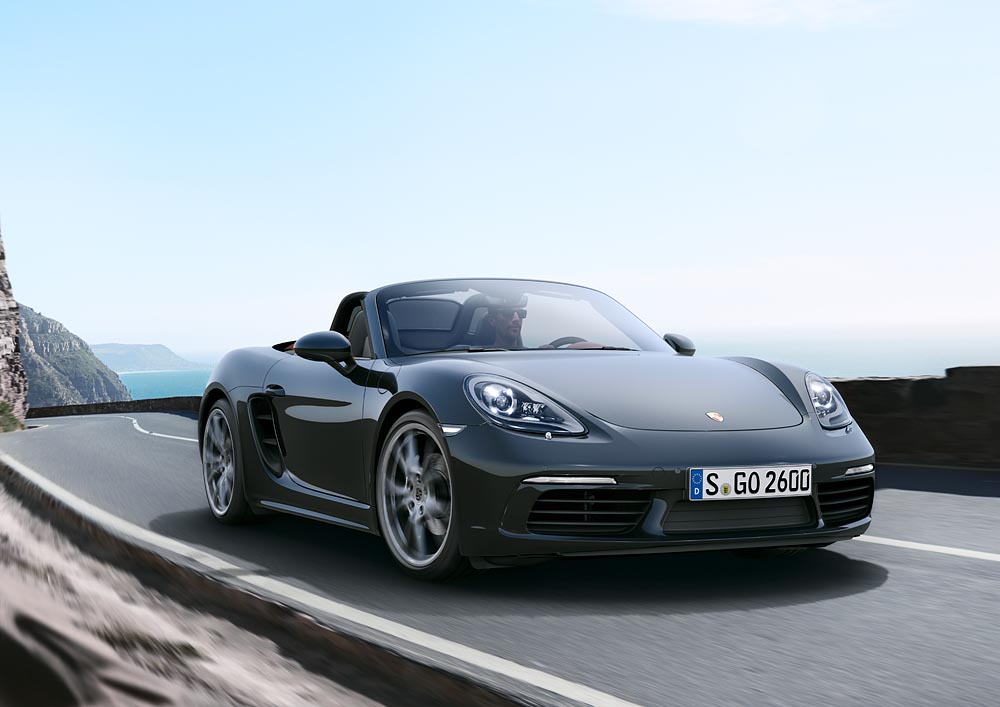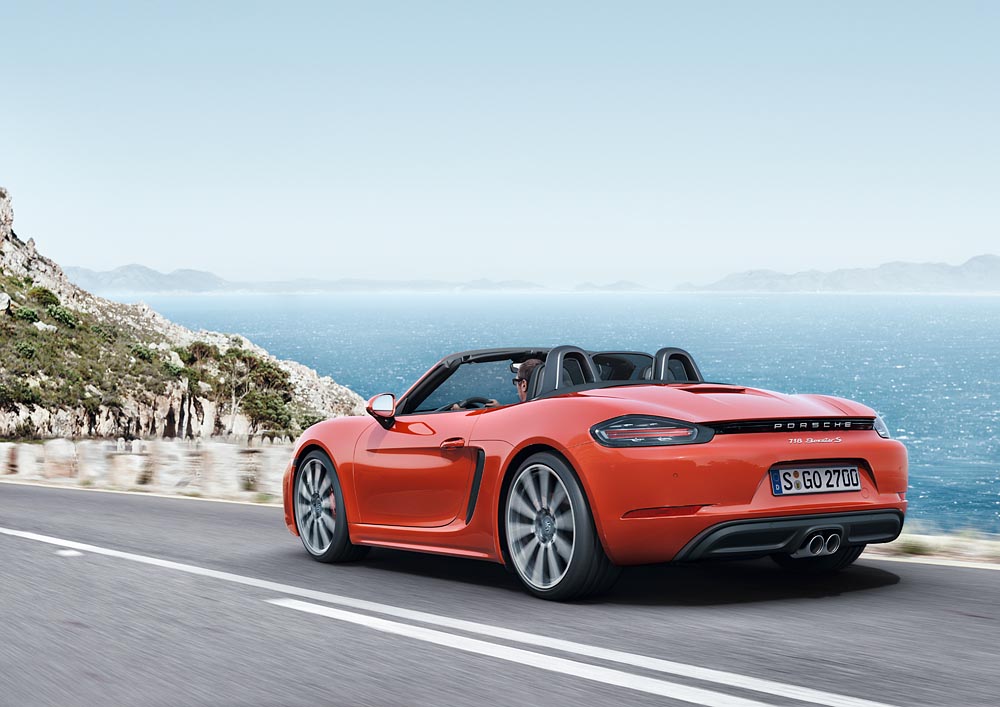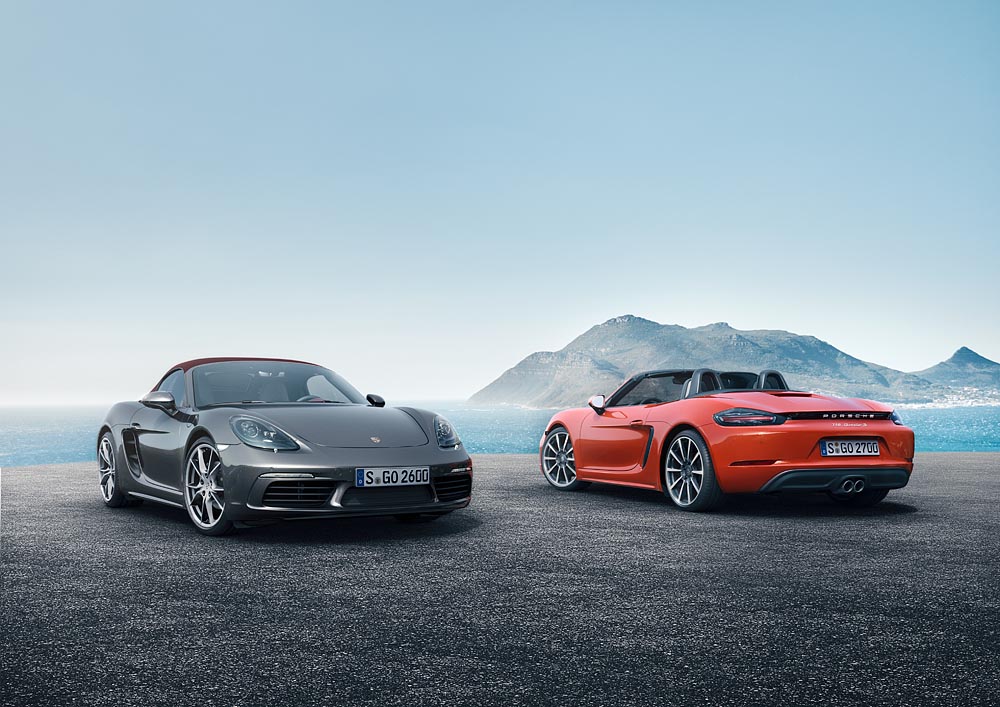Porsche’s Boxster has been around for 20 years. Can you believe that? Where does the time go? In that 20 years, the two-seat roadster has been through three generations and seen engines as large as 3.8 liters in the current Boxster Spyder. The ‘new’ car introduced here gives the Boxster a slightly revised name, a slightly revised visual appearance, and an all-new more-powerful turbocharged four-cylinder engine. There are a few other changes coming with the new bodywork and engine that we’ll outline as well. Many of the changes made to the new 911 Carrera will migrate to the 718 Boxster (and likely the 718 Cayman as well, when that is announced). The headlines, the stuff that Porsche really wants you to know about, however, are “35 horsepower more and 13% better fuel economy“. Those are important figures, to be certain, but what don’t the headlines tell us?
The New Boxster 4-Cylinder Engine
The ‘new’ 718 Boxster features a fresh-from-the-ground-up flat-four engine with turbocharged air. The ‘base’ 718 Boxster will develop 300 horsepower from a 2-liter version of the engine, while the 718 Boxster S will feature 350 horsepower from a 2.5 liter engine (also featuring variable turbine geometry). Across both models, that equates to a 35 horsepower gain over the outgoing 2.7 liter flat-six in the base model and 3.4 liter flat-six in the ‘S’. As we learned already with the Carrera, turbocharging generally shows a significant boost in torque. The two-litre engine of the 718 Boxster has a maximum torque of approximately 280 lb-ft (up from 206 lb-ft), which is available from 1,950 rpm to 4,500 rpm. The 2.5-litre engine of the 718 Boxster S jumps to about 310 lb-ft of torque (up from 266 lb-ft in the old car) which can be found in the range from 1,900 rpm to 4,500 rpm.

How does all of that extra power and torque effect acceleration and top speed? Well, the base car can now get to 60 in 4.7 seconds when equipped with PDK and Sport Chrono (5.2 seconds for the model it replaces). The 718 Boxster S now only needs 4.2 seconds to get from a standstill to 60 MPH when similarly equipped (previously 4.5 seconds were needed). The 718 Boxster is now capable of 171 miles per hour, and the 718 Boxster S extends that top speed to 177 MPH. Impressive when you consider that the old 2.7 liter Boxster could only manage 164 MPH, and the 3.4 liter ran out of muscle at 173 MPH.
As mentioned before, Porsche sees fuel economy improvements of ‘up to 13 per cent’ over the engines these respectively replace. In the 718 Boxster, the four-cylinder flat engine with PDK has a NEDC fuel consumption figure of 6.9 l/100 km (1.0 l/100 km less). In the 718 Boxster S, the 2.5-litre turbo flat engine with PDK consumes just 7.3 l/100 km (0.9 l/100 km less). EPA test route figures have not yet been released, but when they are, we’ll be sure to update you. Part of that fuel efficiency gain can be attributed to PDK’s new virtual intermediate gears, which lessen the strain on the engine revs.

New Chassis Tuning
Specifics on ‘how’ have not really been released, but Porsche claims that the new 718 Boxster and 718 Boxster S have received a “completely retuned chassis” to improve cornering performance. No notes have been made as to whether that will result in higher cornering G-forces or not. The car’s electromechanical steering has been beefed up and reconfigured to deliver 10% more direct steering. I’m not sure how you can measure steering directness in percentage points, but it sure sounds good.
Optional for either the base model or the ‘S’ is a revised Porsche Active Suspension Management (PASM) system, which still features a 10mm decrease in vehicle ride height. Building from there, though, is a new PASM system which features a 20mm decrease in vehicle ride height, however this system is only available as an option for the 718 Boxster S. This active chassis system has been retuned to offer a softer and more comfortable ride in “Normal” mode, and a more dynamic sporty stiffness is now available in Sport and Sport Plus modes.
As we mentioned when Porsche launched the new 911 Carrera, the optional Sport Chrono Package now sees the addition of the “Individual Program” dial on the steering wheel, in addition to the three settings of “Normal”, “Sport”, and “Sport Plus”. The Individual Program option gives drivers the ability to determine how they want their car set up, instead of relying on presets to get the job done. If you want to drive quickly on a bumpy road, you can set your individual preferences for shift speed, throttle response, and exhaust note, while keeping the suspension soft and compliant in “normal” setting.
Interestingly, Porsche also claims that the new Boxster features “stronger brakes”, but does not go into the specifics of how they’ve made that happen. With luck, we’ll find out soon.

The New Look
As with most generation mid-cycle updates and refreshes, the 718 Boxster is just different enough from the previous model that it can be easily picked out of a lineup, but not different enough to distance itself altogether. The new front bumper features a more angular and sculpted look than I’m frankly used to in Porsche designs. They claim that this gives the car a wider and more masculine appearance. The front air ducts have been seriously enlarged to help with the additional cooling needs of the turbocharged engine. They’ve also added the now-traditional Porsche bi-xenon headlights with integrated LED daytime running lights. Full LED headlights with 918-style four-point daytime running lights are optionally available.
When viewed in profile, the new Boxster features revised fenders and a stronger rocker/side sill with deeper design. The side air inlets are larger and now see two fins to emphasis the Porsche’s ‘dynamic look’. Even the door handles have changed, and no longer feature recess covers. The 718 Boxster S will feature new 19-inch wheels as standard, and 20-inch wheels will be available as an option. At the back of the car, the 718 appears wider, primarily due to the accent piece between the tail light assemblies. Porsche has decided to integrate the “PORSCHE” script badge into this accent strip to mixed effect. I’d like to see it in person before passing judgement completely, but for now I’ll hope that an insignia delete option is still on the spec sheets. The tail lights themselves are completely new, featuring ‘three-dimensional LED technology’ and new four-point brake lights.

Inside the car, most everything looks about the same as the outgoing 981 Boxster, with the exception of the revised instrument panel, a new steering wheel, and the large centrally mounted screen. That screen powers the new Porsche Communication Management (PCM) unit with phone integration. No mention has been explicitly made, but it is likely that this system will feature the same Apple CarPlay and Android Auto integration that we’ve seen added to the new Carrera. One can hope, at least. The new system is said to be adaptable to personal requirements, including the option of voice-activated navigation. I’d sure like the opportunity to play with this new unit and compare it to the sub-standard model it replaces.

The market launch of the new Porsche Boxster modles begins on April 30 in Europe, late June in the U.S. and the 3rd quarter for Canada. 718 Boxster and Boxster S German pricing starts at 53,646 euros and 66,141 euros, $56,000 and $68,400 in the U.S. and $63,900 and $78,000 in Canada.
